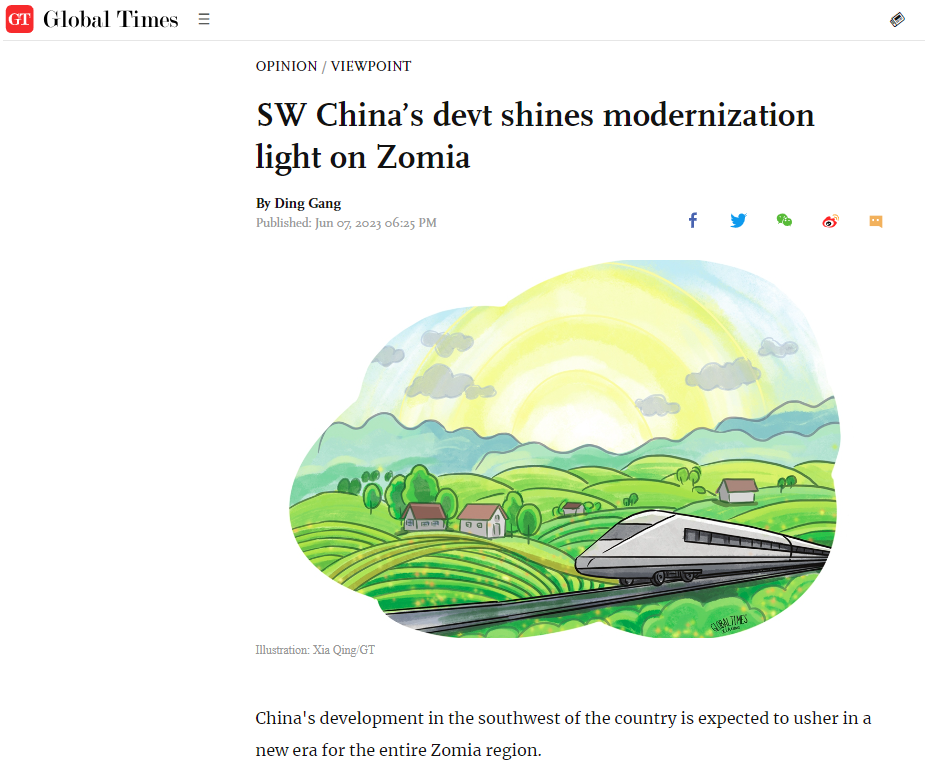LATEST INSIGHTS
Your Present Location: LATEST INSIGHTSDing Gang: SW China’s devt shines modernization light on Zomia
Source: GT Published: 2023-06-07

China's development in the southwest of the country is expected to usher in a new era for the entire Zomia region.
During my recent travels in the mountainous regions of southern Yunnan, the term "Zomia" frequently came to mind.
I had previously mentioned this term in an article about ethnic minorities in Southeast and South Asia bordering China. I focused on the issue then because areas with Zomia characteristics, such as northern Myanmar and India, were suffering from war or conflict while development in China's southwestern border ethnic minority areas was beginning.
"Zomia" is a geographical term coined by historian Willem van Schendel of the University of Amsterdam in 2002 to refer to the northern mountainous regions of South and Southeast Asia, including southern China, Myanmar, Thailand, Laos, Vietnam, and northeast India.
The American scholar James C. Scott argues that the mountainous inhabitants of this region have historically been marginalized politically and culturally, maintaining their independence and autonomy by escaping state control and avoiding the rulers of the plains.
The Zomia region is vast, encompassing several countries and regions, and is home to hundreds of millions of minority populations. It has a complex mix of ethnic groups, significant ethnic identity pluralism, and cultural diversity. They are known by scholars as the "hundred-decker quilt" (a thin quilt made of many different colors and shapes of cloth).
These groups have often suffered from historical squeezing and political marginalization by lowland communities. They have long been influenced by Western colonizers, and remain among the poorest and most economically disadvantaged in the world, with limited access to basic services such as education, healthcare, and clean water.
But I see hope for Zomia in the mountainous southwest of China's Yunnan province, where the sun of modernization has shone into the region.
These ethnic minority regions are an integral part of China's modernization, and they have participated firsthand in this significant progress made over the millennium, enhancing communication and mutual trust with other ethnic groups and strengthening their sense of national identity.
China's poverty alleviation programs have opened up many of China's minority regions, providing access to neighboring areas through new roads and railroads, which will create new opportunities for economic growth and development in the same regions of neighboring countries.
Of course, peaceful and stable growth in this region requires more than just economic development and trade communication.
One of the critical challenges facing Zomia is the risk of ethnic and religious conflicts. The region is home to a wide variety of ethnic and cultural groups, each with its own history, traditions, and identity. These differences can create deep-seated mistrust and hatred between different groups, leading to a state of anarchy that is far removed from central government administration. The problems of wire fraud, kidnapping, and drug trafficking that have emerged in northern Myanmar in recent years are relevant.
The key to addressing these challenges is to promote greater understanding and cooperation among different communities, to encourage more inclusive policies by host governments to build trust with ethnic minorities, to increase ethnic minorities' identification with the state, and to unify state management with regional development. This is a challenging task.
From this perspective, the rapid development of China's border regions has had a positive impact on the area as a whole and provided China with the opportunity to play a more significant role in coordinating joint regional development. China's neighboring countries are also becoming increasingly aware of the importance of China's role in their own development.
Even for India, China's development in the Yunnan, Guizhou, and Tibetan regions, and the railroad to Nepal already on the drawing board, has created a positive incentive for India to deal with its own ethnic issues and to push India to move forward with the opening of border trade.
Through my observations of the Yunnan border region, I have learned that China has the potential power to help stabilize the entire region and that the challenge for China's policy toward the periphery is how to use that power, including the Belt and Road Initiative, to facilitate a move toward peace throughout the region, and that what China itself needs to do is to continue to open up China's border regions to outsiders.
One thing is certain: When the neighboring regions are stable and progressive, China's peaceful development will be more solid and stronger and certainly enhance China's ability to break through the US strategic encirclement.
(The author is a senior editor with the People's Daily and currently a senior fellow with the Chongyang Institute for Financial Studies at Renmin University of China.)
Key Words: Zomia, Southwest Region, Development























































































 京公网安备 11010802037854号
京公网安备 11010802037854号





